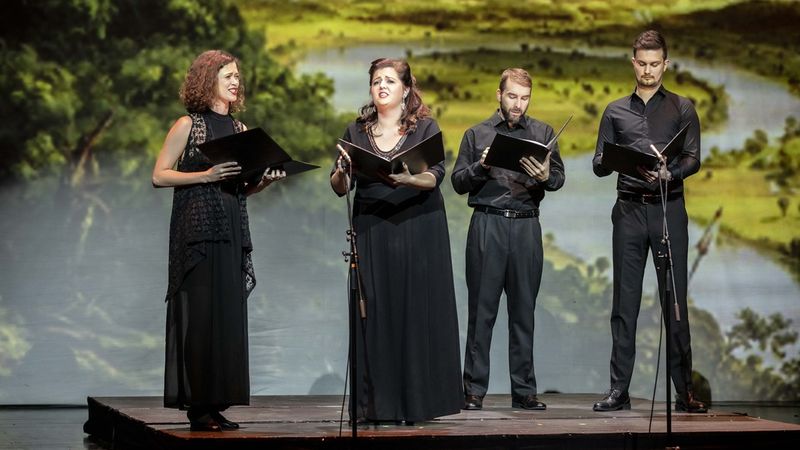
The third episode of the Terzet-Trio-Trois series on 9 October 2020 allowed viewers once again to witness the more intimate moments of the ensembles of the Opera: the Chorus, the Orchestra and the Ballet. In the programme streamed live from the Sándor Hevesi Stage of the Eiffel Art Studios from 8 p.m., apart from a couple of popular melodies, some lesser-known pieces could also be heard. The show offered a virtual tour around the world: sailing on Debussy's boat, crossing a Spanish river barefoot, visiting the imaginary country of Pontevedro, and taking a stroll in the land of fairy tales.
From the almost inexhaustible selection of German Lieder, the Opera Chorus (chorus master: Gábor Csiki) turned to Schumann's Spanisches Liederspiel (Op. 74) based on Spanish folk songs and romances. Rebeka-Asztrid Mitrasca, Júlia Magassy, Balázs Somogyi and Norbert Aronescu evoked the many aspects of love from Erste Begegnung: melodies of passion, passing, melancholy and jealous gossip can all be heard, but we could also learn that if lovers must flee, even the deep waters of the River Guadalquivir cannot stop them. Musical director: Dániel Erdélyi, featured on the piano: Éva Leszkovszki-Tóth.
After the opera adaptations last time, the Opera Orchestra (artistic director: Balázs Kocsár) now offered a very different repertoire: composers of three eras performed by three distinct groups of instruments. Divertimento in G major (Hob. V:20) was performed by Áron Dóczi (violin), Tamás Bíró (violin) and Péter Dóczi (cello). The movements En bateau, Menuet and Cortège from Petite suite by Debussy with orchestrations by András Novák were interpreted by Balázs Rumy (clarinet), Gábor Galavics (clarinet), András Novák (clarinet and E-flat clarinet), Péter Csongár (bass clarinet) and Csaba Pálfi (bass clarinet). Mercenary Serenade composed for three snare drums by Péter Tóth gave a perfect opportunity for percussionist Gáspár Szente, János Tóth and András Császár to excel.
The Hungarian National Ballet (artistic director: Tamás Solymosi) made a selection from the grand productions of recent seasons that had also toured the world. Ronald Hynd's The Merry Widow to music by Ferenc Lehár was first performed by the ensemble in 2014. In later years, it went on a successful tours beyond the borders of Hungary. Valencienne and Camille's pas de deux was performed by Jessica Carulla Leon and András Rónai with Éva Hajnal on the piano. Petipa's classic Don Quixote was revived by Michael Messerer in 2016, two years later it was shown to the New York audience, too. Kitri and Basil's duet was danced by Elizaveta Cheprasova and Ievgen Lagunov. The programme also featured a renowned solo piece by Saint-Saëns The Dying Swan performed by principal Aliya Tanykpayeva. Zsófia Strbka, a student of the Hungarian National Ballet Institute was also featured in the show; she danced variations from Sleeping Beauty by Tchaikovsky, with choreography by Marius Petipa. Don Quixote, The Dying Swan and Sleeping Beauty were accompanied on the piano by Başak Dilara Özdemir Lakatos.
The production was directed by András Aczél, hosted by Melitta Gyüdi.
The performance can be seen HERE.
Photo by Péter Rákossy